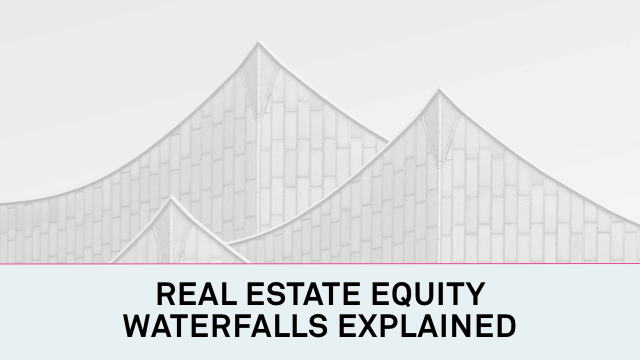Table of Contents
Investing in private equity commercial real estate can be financially rewarding. This is especially the case when the right waterfall model is used for cash distributions. Some models call for a pro rata share of the profits based on the equity invested. This is not necessarily the ideal way to structure a private equity investment.
With the right waterfall model for commercial real estate investing, passive investors may achieve returns on investment above and beyond the targeted ROI by building incentives into the model that rewards all partners when an investment overperforms.
Related: What Is Real Estate Syndication
What is the Waterfall Model?
Private equity firms use the waterfall model in commercial real estate. This is often used to describe the method of distributing cash flow returns among a group of investors in the project.

You may have seen a champagne waterfall at the last wedding you attended or cruise you took. The glasses are stacked in a pyramid shape, and as the glasses at the top are filled the champagne overflows and fills the glasses below, until the bubbly runs dry.
In commercial real estate, the waterfall model works in a similar way, except cash flow is used instead of champagne. In essence, the waterfall model outlines how the distribution of profits from a private equity investment occurs between the Limited Partners (LPs) and General Partners (GPs).
GPs are the investors who take on an active role in managing the day-to-day operations of the investment. Whereas LPs are generally passive investors who are not responsible for the daily business operations.
The waterfall model in commercial real estate is used by
private equity firms to describe the method of distributing cash flow return
among a group of investors in the project.
Because a General Partner is ultimately responsible for how successful the investment is. Typically, the commercial real estate waterfall model can also be designed to reward the GP with a bonus. This is better known as a “real estate sponsor promote” or “carried interest” or just “promote”. It is used to incentivize the GP to exceed the anticipated return from the investment.
Of course, the model of the waterfall structure also works both ways. If the project’s return exceeds expectations, the General Partner may receive a higher share of the profits. However, if the returns are lower than expected, then the GP will receive a lesser share of the profits.
Why is it Important to Have an Owner’s Agreement?
An Owner’s Agreement for a private equity real estate investment describes in detail how the cash will flow. Or more so how the profits will be shared between the GP and the LP investors.
The way a waterfall model is structured can involve several variables. Although there are common terms and sections, each model is designed to satisfy the distinctive requirements of the private equity investment, Limited Partners, and General partner. So, it is important for potential investors to read and understand the owner’s agreement.
In most cases, the owner’s agreement will give LP investors a priority of cash flow distributions until the anticipated return has been reached. By putting the Limited Partners first in line to receive cash flows, the General Partner’s interest is better aligned with those of the Limited Partners. This is because the GP has more direct impact on the project’s success than the passive LP investors.
In most cases, a General Partner will expect to receive an extra share of any excess profits. This is considered compensation for the additional time, effort, expense, and management of potential risks that Limited Partners do not undertake.
For example, a GP actively participates in decisions such as property location, seller negotiation, due diligence, and equity and debt financing structuring.
During the holding period until the property is sold or refinanced, the General Partner has the responsibility to lease up the property, decide how much to spend on tenant improvements, determine the rent level, manage the property, decide when to refinance, and determine the exit strategy that will meet and surpass the projected ROI of the investment.
Related Link: How to Recession-Proof Your Real Estate Portfolio
What are the Common Real Estate Waterfall Model Components?
The Preferred Return
Preferred return (or “pref”) is the order in which the Limited Partner investors and General Partner are repaid their initial investment. This is along with their corresponding share of the profits, until the target return has been reached.
Another way of thinking about preferred return is that LP preferred investors will receive their profit distributions before the other investors and the GP, because they are first in line. Once the return threshold has been achieved, the excess profits will be distributed as outlined in the owner’s agreement.
For example, assume the waterfall model for a private equity real estate investment offers a 10% preferred return and a 80%/20% split for returns above the 10% threshold.
That means Limited Partner preferred investors will receive their proportional share of the distributable cash flow until they have received a 10% ROI. After that, all equity investors will be repaid their initial investments in full. Once the equity investors have received their capital back, 80% of any extra profits will go to LP investors, and the GP will receive 20% as a promote.
The concept of preferred return is easy enough to understand. There are several questions investors should ask before committing money to a private equity real estate opportunity:
- Does the preferred return apply to all equity investors or only certain equity investors? Additionally, can the GP also receive a preferred return on its capital invested?
- If the 10% preferred return is not reached in a given year, will the shortfall be made up in subsequent years? or does the preferred return calculation restart at the beginning of each year?
- Is the preferred return compounded at the preferred rate of return? also, what is the compounding period, such as monthly, quarterly, semi-annually, or annually?
What is the Return Hurdle?
In track and field, hurdling is an event where a runner sprints over a series of obstacles that are a fixed distance apart. The return hurdle in private equity real estate works in a similar way.
A return hurdle is the rate of return that must be crossed before the cash flow can run to the next hurdle in the waterfall. A waterfall model for commercial real estate investing may have multiple hurdles rates and are often measured based on internal rate of return (IRR) or Equity Multiple:
- The IRR represents the percentage of interest earned on every dollar invested throughout the entire holding period. Real Estate investments held over the long term benefit more from the IRR calculation because it offers a more precise representation of the returns a private equity opportunity will produce from start to finish.
- Equity Multiple is calculated by dividing the sum of equity investment plus all profits by the total amount of equity invested. As with IRR, the Equity Multiple ratio is especially useful for commercial real estate investments with longer holding periods because it provides a better understanding of total cash return over the entire holding period of the investment.
When analyzing a private equity real estate deal, an investor should understand from whose perspective the return hurdles will be measured. For example, the hurdle rate could be based on the entire project which may include both the General Partner and Limited Partner investor equity. Or, the return hurdle could be based on only the LP equity, or only the GP equity.
Understanding the net return to a Limited Partner is important, since it measures the anticipated inflows and outflows LP investors may potentially receive, including the returns and promote paid to the GP.
What is Catch Up Provision?
Cash flow distributions in an equity waterfall can be structured to distribute cash flow as a simple split to Limited Partner investors and the General Partner, with a lookback provision, or with a catch up provision.
A waterfall model with a catch up provision requires that LP investors receive 100% of the property’s preferred return until the predetermined rate of return has been reached.
Once the preferred rate of return hurdle has been crossed, only then do proceeds begin flowing to the General Partner. Distributions to the GP continue up until the point where the General Partner has “caught up” or received its rate of return specified in the owner’s agreement.
Limited Partner investors typically prefer an equity waterfall with a catch up provision. This is typically because they get paid first before the General Partner receives any returns. On the other hand, a General Partner may prefer a waterfall model with a lookback provision since they have use of the LPs’ money even if they have to give it back at the end of the period.
Lookback Provision
A lookback provision in a waterfall model for commercial real estate is used to incentivize the General Partner to outperform by generating larger equity and higher cash returns for the Limited Partner investors.
Referencing our previous example, if the GP was able to only achieve the targeted 10% IRR, then the split would remain at 80%/20%, with LP investors receiving 80% and the GP receiving 20%. However, the lookback provision can be structured to compensate the General Partner for overperforming on a private equity deal, in any manner that the Limited Partners and General Partner are comfortable with.
For example, if the GP was able to achieve an IRR of 12% in a given year, the split may change to 70%/30%. If the General Partner was really able to outperform and achieve an IRR of 15%, the split could change to 60%/40%, and so on. Although the split changes in favor of the GP for hitting a home run each year. LP investors are still getting better returns than originally anticipated.
Of course, the lookback provision can also work in reverse.
This occurs when the General Partner and Limited Partners lookback over the entire holding period. If the LP investors did not receive the promised rate of return, the GP would be required to return the portion of the profits needed to provide the Limited Partners with the predetermined rate of return.
Breaking Down a Waterfall Model
A typical waterfall model for commercial real estate may consist of four levels or hurdle rates:
- Level 1: Return of capital with 100% of the distributed cash flow going to the Limited Partners.
- Level 2: Preferred return hurdle rate with cash flow distributed to the LPs until the preferred rate of return on the investment is reached.
- Level 3: Catch up provision where cash flow is distributed to the General Partner until the GP receives its predetermined percentage of the profits.
- Level 4: Lookback provision with the GP receiving a disproportionate share of the distributions if the investment performs better than expected.
Waterfall models in private equity deals can be structured in a countless number of ways. For the sake of simplicity, here’s how a waterfall model for a private equity commercial real estate opportunity might be structured with an anticipated IRR of 10% and an 80%/20% split:
| Level | IRR | Distribution |
| 1 | Up to 10% | 80% LP, 20% GP |
| 2 | 10% – 12% | 70% LP, 30% GP |
| 3 | 12% – 15% | 60% LP, 40% GP |
| 4 | 15% | 50% LP, 50% GP |

Under this waterfall hurdle structure, the LP investors would evenly share profits with the GP when the IRR is 15% or greater, regardless of the amount of equity the General Partner put into the deal. This is an example of the “promote” bonus to the GP discussed at the beginning of this article.
Final Thoughts on the Waterfall Model
Waterfall models in commercial real estate can be difficult to develop and understand, even for investors with years of experience.
For example, although retail, office, and hospitality projects may promise over sized returns to the opportunistic investor, there is arguably a higher level of risk to investing in these asset classes. Minimizing risk and maximizing potential returns are two reasons why many investors choose to diversify their portfolios with private equity multifamily investments.
Investing in private equity commercial real estate can be financially rewarding, especially when the right waterfall model is used for cash distributions.
Determining partner profit distributions for a multifamily property is relatively straightforward. This is especially true for a company like Smartland that understands how to uncover hidden value in ways that traditional investors do not.
With expert renovations and state of the art Class A technologies going into Class B units, Smartland is able to generate higher rents and longer leases. This leads to a greater return of capital for the partners investing alongside Smartland, while building wealth today and for future generations to come.
Are you interested in learning more about Smartland’s investment strategy? Contact us today.
Related Link: The Ultimate Guide to Investing in Rental Properties
FAQs
What is a waterfall, in plain English?
It’s the set of rules that decides who gets paid, when, and how much as a project generates cash. Cash typically flows to pay expenses and debt first, then to investors through tiers that reward meeting or beating targets.
What are the common parts of a waterfall?
You’ll usually see a preferred return, return of capital, one or more performance hurdles, and GP “promote” splits that step up at higher tiers. Some deals include a GP catch-up or an LP lookback to true up results at the end.
How does a preferred return and return of capital work together?
LPs often receive a stated preferred return first (for example 8% per year, not guaranteed), then distributions go toward repaying LP contributed capital. Only after those are satisfied do promote splits typically kick in.
What do tiered splits look like?
After the pref and capital return, profits are shared by hurdle. A simple example: 70/30 to LP/GP until an 11% IRR, then 60/40 to 15%, and 50/50 above 15%. Details vary by sponsor and deal.
What can make a waterfall investor unfriendly?
Front loaded fees paired with rich promotes, loose definitions of key terms (IRR day count, compounding, what counts as “capital”), missing clawback or lookback protections, and catch up clauses that over accelerate GP payouts before LPs hit their targets.
What should I review before committing?
Read the PPM and operating agreement sections on distributions, definitions, and examples. Confirm the order of payments, how the pref accrues, whether there is a GP catch up or LP lookback, how fees interact with distributions, and compare deal level returns to net to LP returns under conservative stress tests.




